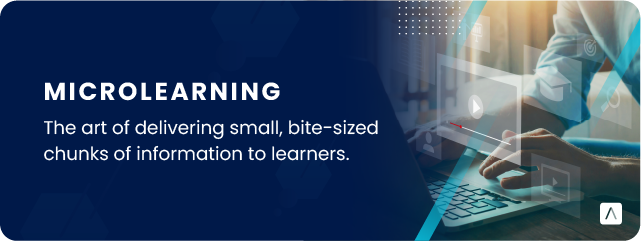What is Microlearning? The Secret Weapon for Building a Culture of Continuous Learning
According to Harvard Business Review, 80% of CEOs say their biggest challenge is the workforce’s need for new skills. Is it yours?
If it is, you may want to consider microlearning as a solution. Many companies have found success in implementing microlearning – and it isn’t hard to do!
In this blog, we’ll unravel the secrets of microlearning. Learn more about the revolutionary approach transforming how individuals and organizations learn.
What is Microlearning?
Microlearning is the art of delivering small, bite-sized chunks of information to learners.
It focuses on specific learning objectives, making it efficient and engaging. This approach allows for quick consumption of content. It has a few results:
- Better retention and application
- Greater engagement in training
- Easier course creation
Microlearning is ideal for busy schedules and dispersed teams. By allowing users to get information faster, they can learn when it makes sense for them. Some may use it in the morning while waiting for the caffeine to enter their systems. Others may use it as a wrap-up at the end of the day.
This method is becoming popular because it just makes sense. About 70% of all training in the workplace comes from someone internally! Microlearning preserves institutional knowledge through things like videos, quizzes, and interactive modules.

Examples of microlearning
Microlearning has extreme versatility. Short videos, quizzes, and infographics, are only a few options. Some examples of microlearning include:
- A 5-minute training video on active listening for new managers
- A quick quiz on product knowledge
- An infographic showing how to submit time off for new employees in onboarding
- A role-playing exercise to show how a marketing initiative should be delivered
These examples show how diverse and engaging microlearning can be. The limits are really in how your L&D team uses it!
Consider this: The average employee only has 24 minutes a week to learn. That’s not a lot of time! You have to make the most of it.
Microlearning Use Cases
Microlearning is a big term for something that looks different in every organization. Since 80% of workforce learning happens on-the-job, it will depend on the job. Still, microlearning reduces training costs by 30% and increases delivery speed by 300%.
What could this look like for your teams?
Microlearning for remote teams
Keeping remote teams engaged and on the same page can be tough for managers. It gets even tougher when you add in some people who do work in an office. Traditional training often doesn’t fit busy schedules or scattered time zones.
How can microlearning help?
With microlearning, remote workers learn new skills and policies, regardless of time zone. With a learning management system, managers can track who has completed the training. They then know who to talk to about finishing the training. It’s a great way to ensure a fair application of standards within your workforce.
How can this improve your workforce? Greater communication, knowledge sharing, and a more cohesive remote work experience. You’re able to have a true culture of learning, even if people aren’t in the same office.
Microlearning to build soft skills
Soft skills like communication, teamwork, and problem-solving are crucial for workplace success. However, developing these skills takes time and dedicated effort. It’s a challenge – especially in workplaces where not everyone sees the benefits.
How can microlearning help?
Microlearning provides short, focused lessons on essential soft skills. Employees learn at their own pace and integrate these skills when they can. It also takes up a smaller amount of time, quieting the concerns of many naysayers.
How can this improve your workforce? You’ll have a more effective and well-rounded workforce, fostering collaboration and positive interactions.
Microlearning for mental wellness
Work-life balance can be a struggle, leading to stress and burnout. It’s a problem that people leaders cannot seem to outrun.
How can microlearning help?
Believe it or not, training is a stressor for many employees. Whether it’s retention or fitting it into schedules, it impacts their mental health. You have to remember The Forgetting Curve. Within 1 hour, employees forget 50% of new information. Within 1 day, they have forgotten 70%. Within 1 week, they have forgotten 90% of what they learned.
How can this improve your workforce? A happier, healthier workforce with increased productivity and reduced absenteeism.
Microlearning for innovation
Encouraging creativity and fostering a culture of innovation can be difficult. Businesses need to move fast, and innovation sometimes falls by the wayside.
How can microlearning help?
Microlearning can introduce employees to new ideas, problem-solving techniques, and design thinking tools. By presenting this information in shorter formats, they don’t seem as scary or risky. They seem like little things your employees can work into their days.
How can this improve your workforce? New ideas and perspectives can lead to better results! While not every new idea is a winner, innovation is imperative as technology changes.
Benefits of microlearning
Microlearning offers flexibility, allowing learners to access bite-sized information anytime, anywhere. This leads to improved retention and application of knowledge in real-world scenarios.
Additionally, its interactive nature promotes engagement and increases motivation. It starts to position training as something that is fun. It’s a nice break from day-to-day rigor, especially with video, humor, and gamification.
The biggest reason to switch to microlearning? Compared to traditional training methods, businesses see staggering improvements:
Challenges of microlearning
While microlearning offers flexibility, some may find it challenging. The biggest problem is covering complex topics in bite-sized modules. The concern is that learning may miss the big picture. This puts some of the responsibility on the learner to retain information. However, it also encourages trainers and mentors to think about the topics themselves.
The other challenge is implementation of microlearning. With the help of a learning management system, it’s easier than ever. Mitratech’s learning management software can help HR leaders and managers break down information. Whether you want to do 5-minute courses assigned daily or 10-minute courses assigned weekly, we can help. Click here to schedule a demo today.
Implementation and Tools
When it comes to implementing microlearning, having the right tools is essential. You can’t just hack up existing courses and expect results. Instead, you need to be thoughtful, though you don’t need to recreate the wheel.
Utilizing learning software streamlines the process and makes it easier to create content. You can then track the effectiveness of those modules with built-in learning analytics. (If your chosen LMS has them!) The best way to watch is to tie performance management into learning management.
Microlearning software
Are you looking for the right tools to implement microlearning in your organization? Microlearning software is designed to deliver bite-sized learning modules efficiently. Not all software is built for this!
Mitratech’s learning management software actually breaks down courses into different modules and stages. It saves user progress so that they can take these courses on their own. It puts the responsibility on employees to find what works for them.
With interactive features, analytics, and customization options, it makes microlearning easier. It’s a no-brainer for companies looking to improve their training programs.
Microlearning Best Practices
When it comes to microlearning, incorporating best practices is key for successful implementation. To start, keep content concise and focused on one learning objective per module. This ensures maximum retention and engagement from learners. Additionally, make sure to include interactive elements like quizzes or simulations!
Microlearning best practices
Microlearning best practices will once again vary from company to company.
However, they always involve keeping content concise and engaging, focusing on one thing.
A few other best practices include:
- Utilize multimedia formats like videos or interactive quizzes to enhance retention.
- Track the success of your programs using analytics data.
- Encourage learner participation through gamification elements.
- Use learning management software to help facilitate microlearning. It takes the manual efforts away from your HR team!
- Have focus groups where you talk about how employees feel about the shift.
- Tie your new learning initiatives into performance management.
- Try microlearning with an entire cohort for onboarding to see if it makes a difference.
- Provide immediate feedback for continuous improvement.
Leveraging microlearning for continuous development
Continuous development is a powerful strategy that transforms how organizations approach development. And microlearning only helps these efforts!
By implementing microlearning, employees are engaged, motivated, and smarter. With the right tools, platform, and implementation, businesses can harness the full potential of microlearning. At the same time, they’ll drive innovation, improve performance, and stay competitive.
As technology continues to evolve and new challenges arise, embrace microlearning as a secret weapon. Not only for learning, but for building a culture of continuous development. This isn’t something that will go away. By prioritizing ongoing professional development, organizations empower their workforce to adapt and thrive.
In the end, Microlearning is not just a trend. It’s a strategic approach that revolutionizes how we learn and grow at work.
The future of employee development is here
The future of employee development lies in embracing this innovative approach. By incorporating microlearning into your organization’s culture, you can foster a more dynamic and adaptable workforce ready to tackle any challenge that comes their way.
To learn more about Mitratech’s learning management system, click here to request a demo. We’ll be happy to tell you more about our software and how you can use it.
Got the resources to meet return-to-work challenges?
Mitratech offers the right solutions and support to help you pivot to meet post-pandemic demands.



